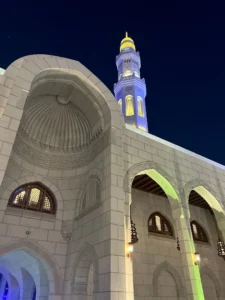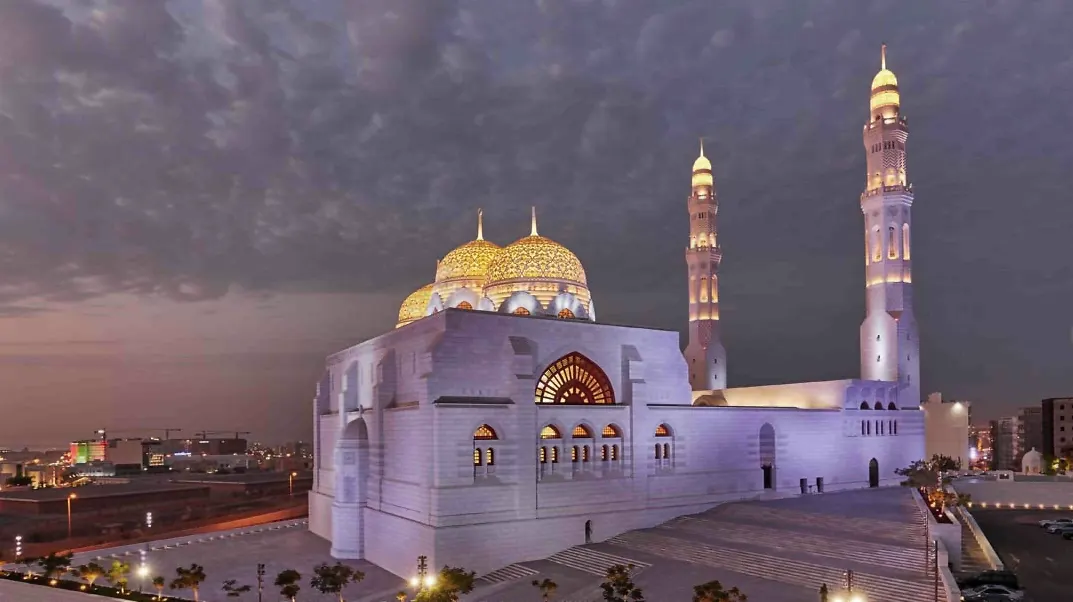Information about Mohammed Al Ameen Mosque Muscat
Mohammed Al Ameen Mosque Muscat rises against Muscat’s skyline with its gleaming white marble facade and tall minarets that pierce the azure Omani sky. This architectural masterpiece engages visitors with more than just its religious significance. The structure showcases a perfect blend of traditional Islamic design and modern engineering excellence.
The mosque’s remarkable structure combines centuries-old Islamic architectural principles with state-of-the-art features. Each element, from the intricate geometric patterns to the calculated acoustics, reflects a story of artistic vision and engineering precision.
This piece will help you learn about the mosque’s architectural vision, construction materials, artistic elements, and cultural significance. The magnificent structure serves as a spiritual haven and stands proud as a symbol of Oman’s architectural heritage.
The Architectural Vision Behind Mohammed Al Ameen Mosque
My first sight of the Mohammed Al Ameen Mosque in Muscat left me amazed by its remarkable simplicity—a defining characteristic that distinguishes it from traditional mosque architecture. The spiritual sanctuary, completed in 2014, charts a bold new path away from conventional Islamic design while keeping its deep roots in religious symbolism.
Blending traditional Islamic and modern design elements
The mosque captivates visitors with its perfect balance of tradition and state-of-the-art design. The architecture adopts clean lines and subtle esthetics that create a contemporary interpretation of Islamic design for modern sensibilities. A magnificent central dome draws all eyes upward, while two elegant minarets reach toward the heavens.
The mosque’s key design elements reveal this harmonious fusion:
- A striking blue dome dominates the structure
- Two graceful minarets frame the main building
- Clean, uncluttered facades emphasize spiritual serenity
- High-end finishes blend naturally with traditional elements
Influence of Omani architectural heritage
The mosque’s design clearly draws inspiration from Oman’s rich architectural legacy. Its structure shows a deep understanding of traditional Omani Architecture and reimagines familiar elements in a modern context. This delicate balance helps the mosque serve as both a contemporary landmark and a guardian of cultural heritage.
The role of contemporary engineering
The engineering matches the mosque’s esthetic appeal. The integration of modern construction techniques with traditional craftsmanship creates something truly special. Sophisticated marble cladding, intricate decorative marble work, and complex timber elements demonstrate what happens when contemporary engineering meets classical design.
The mosque stands apart through its unique space that feels both timeless and contemporary. Visitors can appreciate how the architects created a structure honoring Islamic architectural traditions while adopting modern design and engineering possibilities. The building stands as proof of Oman’s dedication to religious harmony and architectural excellence.

Masterful Materials and Construction
The cool, smooth surface of the Mohammed Al Ameen Mosque’s walls reminds me of its extraordinary craftsmanship. This architectural marvel took shape between 2008 and 2014, bringing together materials and expertise from around the world.
The significance of marble in Islamic architecture
The mosque’s stunning marble cladding stands out as its defining feature, covering 20,300 square meters of space. The white marble creates a sense of purity and grandeur that serves as a perfect canvas. Hand-carved Islamic patterns stretch across 3,000 square meters, revealing the timeless beauty of Islamic artistic expression.
Integration of global craftsmanship
This mosque stands as a testament to international collaboration. Expert teams from different countries came together to create this masterpiece:
- Iran and Italy provided design expertise
- Germany and Austria contributed technical knowledge
- India brought artistic excellence
- UK teams delivered engineering solutions
Rich wooden carvings complement the white marble backdrop throughout the interior spaces. The main prayer hall features an 11-meter tall chandelier that showcases this collaborative spirit. This masterpiece gleams with 24-karat gold plating and sparkles with Swarovski crystals.
Modern construction techniques
The mosque blends contemporary design with timeless appeal through modern building methods. Its main prayer hall spans 1,616 square meters and comfortably fits 2,100 worshippers, showing remarkable engineering precision.
Traditional craftsmanship merges perfectly with modern technology throughout the structure. Contemporary Omani style flows naturally through the interior spaces, creating an authentic yet forward-looking atmosphere. Every detail shows meticulous attention – from perfectly matched marble panels to sophisticated lighting that highlights the mosque’s architectural beauty.
Artistic Elements and Sacred Geometry
The sacred halls of Mohammed Al Ameen Mosque left me spellbound. Light and shadow dance across its surfaces in a mesmerizing display. My eyes are drawn to the absence of human and animal figures in its decorative elements – a reflection of Islam’s deep connection to abstract beauty and geometric harmony.
Islamic geometric patterns and their meaning
The mosque’s artistic expression embodies traditional Islamic principles where beauty emerges from abstract patterns rather than figurative art. The decorative elements showcase three distinct motifs:
- Complex tessellations that form infinite geometric patterns
- Natural plant-inspired arabesques
- Stylized Arabic calligraphy with religious texts
The 3,000 square meters of hand-carved stone artworks fascinate me deeply. Each pattern tells its story through mathematical precision and spiritual significance. These intricate designs go beyond mere decoration. They invite reflection on the infinite nature of creation.
Calligraphy and decorative elements
The blend of calligraphy and ornamental patterns creates a visual symphony throughout the mosque. The contemporary Omani style shines through richly carved woods set against pristine white marble backgrounds. This artistic choice brings both beauty and serenity to the space.
The decorative elements strike a perfect balance between intricate detail and simplicity. Hand-carved artworks display complex Islamic patterns that honor traditional art while appealing to modern tastes.

Lighting design and natural illumination
The mosque’s artistic design reaches its peak in its masterful use of light. Sunlight streams through carefully placed windows and creates an ever-changing spectacle throughout the day. Beautiful chandeliers add another layer to the lighting scheme. The centerpiece chandelier sparkles with 67,000 Swarovski crystals.
The mosque becomes a golden beacon as night falls. Its domes glow warmly against the dark sky while blue lights create an ethereal atmosphere around the structure. You can see this beautiful sight from every highway approaching Muscat. The lighting transforms the mosque’s beauty from day to night, offering two distinct but equally stunning views.
Interior Spaces and Spiritual Design
The moment I walk into the main prayer hall of Mohammed Al Ameen Mosque, a profound sense of peace washes over me. This masterpiece of spiritual architecture surrounds me with elements that blend practical use and symbolic meaning.
Main prayer hall architecture
The main prayer hall’s size amazes me at 1,616 square meters – enough space for 3,000 worshippers during busy times. The space creates perfect harmony between function and spiritual beauty. You’ll find:
- Soft, plush carpets that provide comfort during prayer
- Pure white Italian Carrara marble adorning the columns and walls
- A magnificent 10-meter high timber door at the main entrance
- Four cast bronze doors with decorative colored glass
The design impresses me with its thoughtful separation of prayer areas for men and women. This approach respects Islamic principles and ensures everyone has equal access to spiritual spaces. A full-fledged library and classrooms make this sacred space a thriving learning hub for local community members.
The symbolism of the dome and minarets
The mosque’s central dome catches my eye immediately. Its elegant shape dominates the interior and stands as a powerful symbol of unity and faith. Sunlight streams through carefully placed openings in the dome, creating an otherworldly atmosphere that deepens the spiritual experience.
Beautiful patterns cover the dome’s interior ceiling, drawing your gaze upward. Strategically hung chandeliers add elegance to this sacred space. Natural and artificial light work together throughout the day, reflecting the changing nature of spiritual reflection.
Acoustic considerations in sacred spaces
The mosque’s acoustic design fascinates me most. Expert engineering ensures every worshiper hears both the call to prayer and the Imam’s words clearly during services. The mihrab, a semicircular niche facing Mecca, does more than show direction – it helps project the Imam’s voice throughout the prayer hall.
Sound design meets three key needs: individual prayer, group worship, and Quranic recitation. Sound-absorbing carpets and reflective surfaces work together to create the perfect environment for all these activities. The dome’s shape helps distribute sound so spiritual messages reach every corner with warmth and clarity.

Cultural Impact and Modern Identity
The Mohammed Al Ameen Mosque stands majestically 62.5 meters above sea level. This magnificent structure has grown into an essential part of Muscat’s cultural identity since 2014. A private investment of 40 million Omani rials created more than just an architectural masterpiece.
Role in contemporary Omani society
The mosque amazes me with its growth into a thriving community center. My visits have shown how it serves many purposes in today’s Omani society:
- A center for religious education and cultural dialog
- A gathering space for community events and charitable initiatives
- An educational facility with a complete library
- A symbol of Oman’s steadfast dedication to religious tolerance
The library stands out with its remarkable collection of books on language studies, Omani history, and religious texts. This space has naturally become a learning hub that encourages both spiritual development and academic growth.
Influence on modern Islamic architecture
The mosque’s design serves as a model for modern Islamic architecture. The structure shows how today’s design can respect traditional principles while embracing innovation. Its unique character comes from blending spiritual authenticity with modern features.
The building’s influence on modern Islamic architecture shows in several ways:
- The use of environmentally responsible design principles
- Modern materials working alongside traditional elements
- Features that make it available to disabled visitors
- A perfect mix of minimalist esthetics and sacred geometry
Cultural preservation through design
The Mohammed Al Ameen Mosque shows how thoughtful design preserves culture. The architects created spaces that beautifully reflect both Islamic values and Omani heritage. The design creates harmony between buildings and nature. It respects traditional principles yet meets today’s needs.
The building preserves culture through three main elements:
- Traditional Islamic architectural features
- Local design motifs and patterns
- Environmental practices that honor heritage and ensure longevity
Visitors from different backgrounds learn about the mosque daily. They can join guided tours that explain Islamic traditions and architectural significance. This welcoming approach matches Oman’s spirit of tolerance and hospitality.
The mosque reaches far beyond its physical presence. Programs and activities help pass cultural values to future generations. This balance between old and new has transformed it into a living cultural institution that connects past and present.
Conclusion
The Mohammed Al Ameen Mosque surpasses its role as a place of worship. This architectural marvel shows how spiritual spaces can welcome modern breakthroughs while preserving sacred traditions.
The mosque features pristine marble surfaces and intricate geometric patterns. Its thoughtfully designed prayer halls and community spaces create an atmosphere of profound spiritual connection. The soaring minarets and crystal-adorned chandeliers showcase artistic excellence and engineering precision.
This magnificent structure plays multiple vital roles in contemporary Omani society. The mosque serves as an educational center and cultural bridge. It symbolizes Oman’s steadfast dedication to preserving its rich heritage while embracing the future.
Great architecture lifts our spirits and connects us to something greater than ourselves. The Mohammed Al Ameen Mosque will continue inspiring visitors and worshippers alike. It stands as proof of faith’s enduring power expressed through architectural excellence.

















